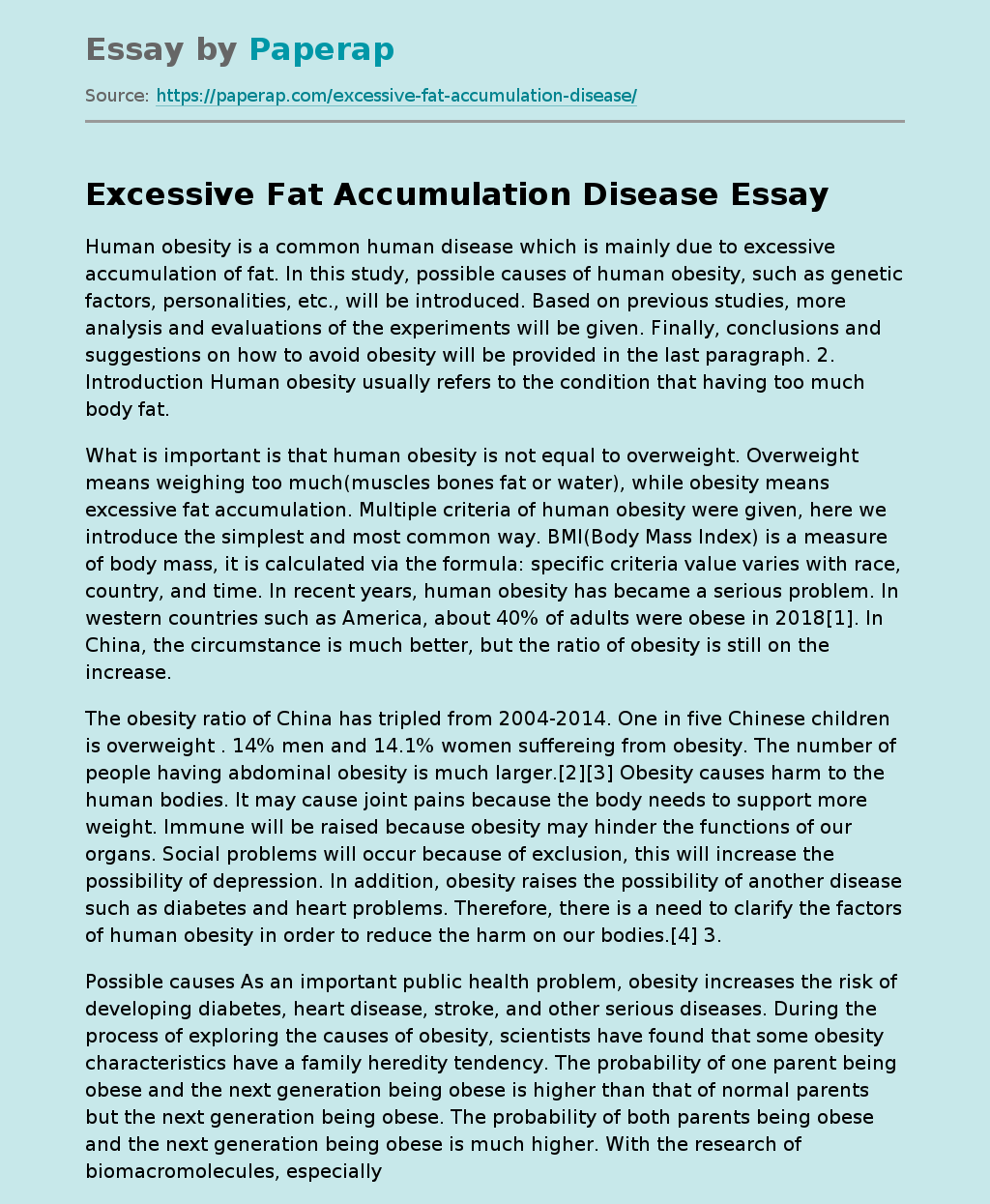Excessive Fat Accumulation Disease
Human obesity is a common human disease which is mainly due to excessive accumulation of fat. In this study, possible causes of human obesity, such as genetic factors, personalities, etc., will be introduced. Based on previous studies, more analysis and evaluations of the experiments will be given. Finally, conclusions and suggestions on how to avoid obesity will be provided in the last paragraph. 2. Introduction Human obesity usually refers to the condition that having too much body fat.
What is important is that human obesity is not equal to overweight.
Overweight means weighing too much(muscles bones fat or water), while obesity means excessive fat accumulation. Multiple criteria of human obesity were given, here we introduce the simplest and most common way. BMI(Body Mass Index) is a measure of body mass, it is calculated via the formula: specific criteria value varies with race, country, and time. In recent years, human obesity has became a serious problem. In western countries such as America, about 40% of adults were obese in 2018[1].
In China, the circumstance is much better, but the ratio of obesity is still on the increase.
The obesity ratio of China has tripled from 2004-2014. One in five Chinese children is overweight . 14% men and 14.1% women suffereing from obesity. The number of people having abdominal obesity is much larger.[2][3] Obesity causes harm to the human bodies. It may cause joint pains because the body needs to support more weight. Immune will be raised because obesity may hinder the functions of our organs. Social problems will occur because of exclusion, this will increase the possibility of depression.
In addition, obesity raises the possibility of another disease such as diabetes and heart problems. Therefore, there is a need to clarify the factors of human obesity in order to reduce the harm on our bodies.[4] 3.
Possible causes As an important public health problem, obesity increases the risk of developing diabetes, heart disease, stroke, and other serious diseases. During the process of exploring the causes of obesity, scientists have found that some obesity characteristics have a family heredity tendency. The probability of one parent being obese and the next generation being obese is higher than that of normal parents but the next generation being obese. The probability of both parents being obese and the next generation being obese is much higher. With the research of biomacromolecules, especially genes and proteins, it is known that genes control the synthesis of proteins, and proteins directly control the biological characters. Therefore, one explanation for genetic obesity is that it’s caused by genes. Recent studies have shown that with the discovery of more than 50 genes closely related to obesity, genetics leads to 40-70% of obesity[1].
It is currently accepted that mutations in genes implicated in the coding and synthesis of proteins involved in appetite regulation are responsible for pathological changes associated with the development of obesity[2]. The genetic types of obesity can be generally divided into three categories: monogenic obesity which are caused by a single gene mutation; polygenic obesity which are caused by the cumulative contribution of a large number of genes and syndromic obesity which are caused by genetic defects or chromosomal abnormalities in individual genes and associated with other phenotypes[3]. Genes related to obesity can be generally divided into the following aspects: coding of peptide transmitting hunger and satiety signals; genes involved in adipocyte growth and differentiation processes; genes involved in regulation of energy expenditure control and altered expression of genes related to insulin metabolism and adipose tissue inflammation.
Many genes for obesity disrupt the regulatory system for appetite and weight, which are listed as the table 1 and this table shows the function of gene products in energy balance. And the figure 1 shows the relationship between the energy intake and energy expended. Some specific description of genes are as follows. Table 1: genes with variants that have been associated with obesity[4] Figure 1: energy balance and obesity[5] FTO gene mutation: so far, this gene has the greatest impact on the risk of obesity phenotype. Each risk allele in FTO is associated with a 1-1.5 kg gain in weight and a 20-30% increase in obesity risk. FTO gene plays an important role in controlling food intake, energy homeostasis and energy consumption. GWAS research shows that FTO gene is the most important candidate gene which jointly affects obesity in adults and children and type 2 diabetes in European and Asian populations[5].
Leptin mutations: it is secreted by white adipose tissues mediated directly through the CNS and inhibits food intake. Leptin conveys information to the hypothalamus regarding the amount of energy stored in adipose tissues and helps in the suppression of appetite and stimulates energy expenditure It affects metabolic processes like fatty-acid oxidation by activating AMP-activated protein kinase. In addition, leptin also affects the immune response by influencing regulatory T cell function[5].
Excessive Fat Accumulation Disease. (2021, Dec 03). Retrieved from https://paperap.com/excessive-fat-accumulation-disease/

